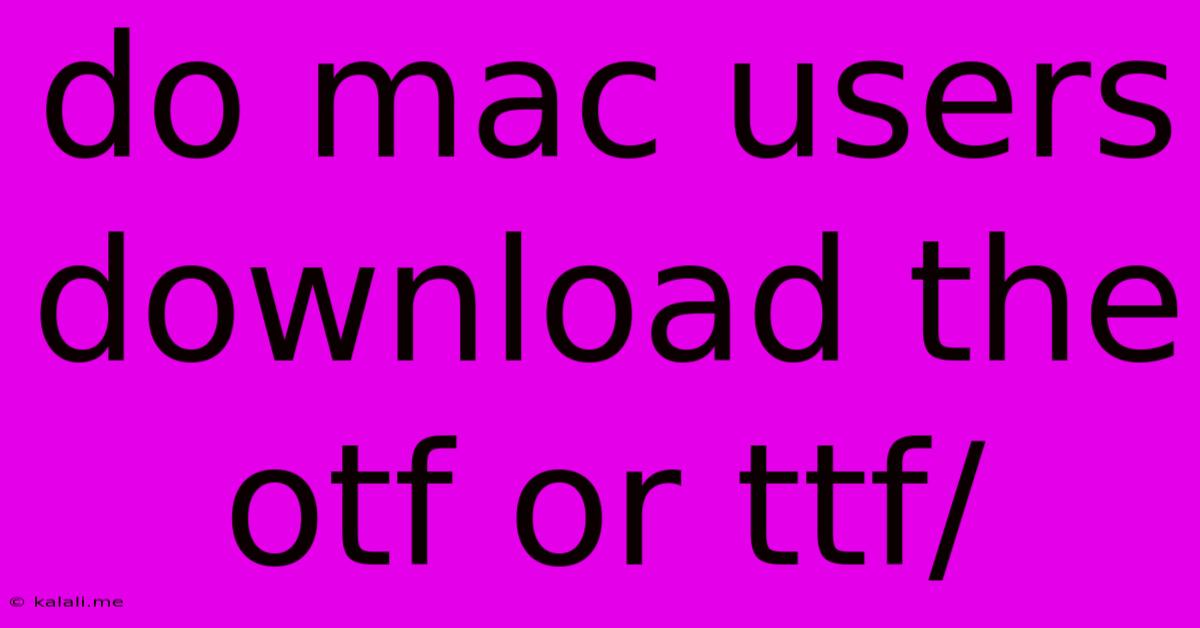Do Mac Users Download The Otf Or Ttf/
Kalali
Jun 04, 2025 · 3 min read

Table of Contents
Do Mac Users Download OTF or TTF Fonts? The Ultimate Guide
Choosing between OTF and TTF fonts might seem like a minor detail, but understanding the differences can significantly impact your workflow and the overall quality of your design projects. This guide clarifies whether Mac users should download OTF or TTF fonts, and explains why the answer isn't as simple as you might think. Ultimately, the best choice often depends on your specific needs and the fonts themselves.
Meta Description: Learn the difference between OTF and TTF font formats, and discover which is best for Mac users. We cover compatibility, features, and more to help you make the right choice for your design projects.
Understanding OTF and TTF Font Formats
Both OpenType (OTF) and TrueType (TTF) are font formats used to display text on screens and in print. They both contain the same essential information: outlines of letters, glyphs (symbols), and kerning (letter spacing) data. However, there are key differences:
-
OTF (OpenType Font): Generally considered the more modern and versatile format. OTF supports a wider range of characters, including advanced typographic features like ligatures (combined characters like "fi" or "fl"), and stylistic alternates (different versions of the same letter). It also tends to offer better hinting (adjustments for crispness on low-resolution screens). OTF files can often be larger than TTF files.
-
TTF (TrueType Font): An older format, TTF fonts are still widely used and compatible with almost all operating systems and applications. While generally simpler than OTF, they are perfectly adequate for many design needs and offer good rendering quality.
Mac OS Compatibility: OTF vs. TTF
The good news is that both OTF and TTF fonts are fully compatible with macOS. Your Mac will happily render both formats without any issues. So, the choice doesn't stem from operating system limitations.
Which Font Format Should You Choose?
The decision of whether to download OTF or TTF largely depends on the specific font and its features:
-
Prioritize OTF: If the font offers advanced typographic features like ligatures, stylistic alternates, or extensive character support (especially for international languages), choose the OTF version for the best possible results. These features significantly enhance the quality and sophistication of your typography.
-
Consider TTF: If the font doesn't offer advanced typographic features, or if file size is a major concern (especially when working with many fonts), a TTF file might be suitable. The difference in rendering quality between a well-designed TTF and OTF is often negligible for basic text.
-
Check the Font Provider's Recommendation: Many font foundries will explicitly state which format they recommend. Always check their website or documentation for guidance.
Font Management on Mac
Regardless of whether you choose OTF or TTF, effective font management is crucial. Avoid installing too many fonts at once, as this can slow down your system. Use a dedicated font manager application to help organize your font library and prevent conflicts.
Conclusion
In summary, Mac users don't need to worry excessively about choosing between OTF and TTF fonts. Both are fully supported. The best choice hinges on the font's features and your specific needs. If advanced typographic features are essential, choose OTF. If not, TTF offers a perfectly viable alternative. Remember to prioritize good font management practices for optimal performance.
Latest Posts
Latest Posts
-
When You Re Available Next Or Next Availble
Jun 06, 2025
-
How To Disable Ds4 In Steam
Jun 06, 2025
-
Toilet Not Flushing And Filling Up With Water
Jun 06, 2025
-
How Big Of A Tank Does A Goldfish Need
Jun 06, 2025
-
What Does Jss Mean In Walking Dead
Jun 06, 2025
Related Post
Thank you for visiting our website which covers about Do Mac Users Download The Otf Or Ttf/ . We hope the information provided has been useful to you. Feel free to contact us if you have any questions or need further assistance. See you next time and don't miss to bookmark.